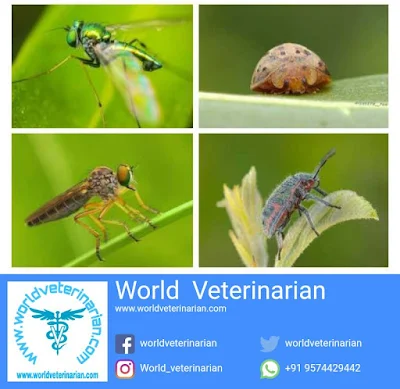LUMPY SKIN DISEASE (LSD)
· It’s acute,
sub-acute or chronic viral disease of cattle Caused by capripox virus and which
is characterized by fever, Oedema of skin, Formation of nodules on skin and
mucous membrane of internal organs, enlargement of lymph nodes and increased
nasal discharge.
Synonyms:
·
Pseudourticaria
·
Neethling
virus disease
·
Exanthema
nodularis bovis
It’s acute, sub-acute or
chronic viral disease of cattle which is characterized by
ü Fever
ü Large lymph nodes
ü Increased nasal discharge
ü Oedema of skin
ü Formation of nodules on skin and mucous membrane of
internal organs
DISTRIBUTION
·
LUMPY
SKIN DISEASE (LSD) now endemic in Southern Africa, Europe and Asian countries.
·
It’s
sporadic in India and Bangladesh.
·
Lsd
outbreaks among cattles was reported in
odisha in india
ETIOLOGY
·
Family:
Poxviridae
·
Caused
by capripox virus of
·
It’s
double stranded DNA virus.
·
Enveloped
virus having brick shape and it replicate in cytoplasm.
HOST
·
Cattle,
Buffalo, yak.
·
RESERVOIR HOST: Giraffe, Impala, Arabian Oryx, gazelle.
TRANSMISSION
·
Mosquitoes
·
Ticks
·
Infection
via skin lesion
·
Through
infected bull semen
·
Other
secretions and Iatrogenic.
PATHOGENESIS
Entry of virus through skin or respiratory tract
⇓
Local virus replicate in epidermis , dermis (keratocytes)
, or in respiratory epithelium
⇓
Virus enter in local lymph node and also in
reticulo-endothelial cells
⇓
Virus got identified by macrophages and replicate in
cytoplasm of macrophages
⇓
Virus exits via efferent lymphatic vessels into blood.
⇓
Virus disseminate Into the body and Enter skin via
infected macrophages.
⇓
Replicate in endothelial cells.
⇓
Infected cells release cytokines and cytokine induced
vasodialation.
⇓
Increased vascular permeability, leukocyte chemotaxis
cause oedema and local inflammation
⇓
Langerhan cells close contact with endothelial cells in
malphigian layer of skin.
⇓
Virus infect Langerhan cells and spread to endothelial
cells of stratum basale and spinosum.
⇓
All these cells allow virus to replicate in them.
⇓
Stratum basale and spinosum gets necrosed and forms
exudate filled nodules with debris cells.
⇓
Through adaptive immune response the the virus infection
is resolved and the nodule gets healed and forms a scar.
CLINICAL SIGNS
·
Invasive form :- fever (105-106°F)
§
Enlarged
lymph nodes
§
Conjunctivitis
§
Lachrymation
and hyper salivation
§
Nasal
discharge ( thick off white mucoprulent)
§
Eruption form:- Firm,
§
Round,
painless and circumscribed nodule.
§
Oedema
in legs, loins, dewlap and skin
§ Necrosis
form:- deep wound with a “punched out” appearance
§ “inverted
conical zone" of necrosis or “sit fast necrosis”
§
Mild form:- enlarge lymph node nodules over entire body healing
§
Within
3 to 6 weeks.
§
Severe form:- difficult and noisy breathing due to nodules
§
Oedema
in phyrnx and larynx.
§
Cessation
of rumination
§
Nodules
on oesophagus
§
Death
due to asphyxia
GROSS PATHOLOGY
ü Pox lesion mucous membrane pharynx, trachea and udder.
ü Yellow-red tinged oedematous fluid in s/c
ü Nodules involving all layers of skin, digestive and respiratory systems
ü Nodules and hemorrhages in facia over limb muscle and s/c tissue
ü Nasal mucus and oropharynx is ring appearance peculiar due to separation of
necrotic epithelium to healthy tissue
MICROSCOPIC PATHOLOGY
ü Acanthosis with orthokertatotic or hyperkeratosis
ü Hydronic degeneration (ballooning) of epidermal cells
ü Intracytoplasmic eosinophilic viral inclusion bodies
ü In superficial And deep dermis is moderate to severe perivascular
infiltration
SEQUALE
ü
Mastitis
due to secondary bacterial infection
ü
Lamness
due to inflammation and necrosis of joint, tendon
ü
Pneumonia
ü
Abortion,
intrauterine infection in cow
DIAGNOSIS
·
Field
presumptive diagnosis (clinical signs and PM lesion)
·
Generalized
skin multiple nodules
·
Inverted
conical necrosis of skin nodules
·
Persistent
fever with low mortality
Laboratory diagnosis
·
Virus
Isolation on cell culture -egg Inoculation
·
Electron
microscopy
·
FAT,
AGID, ELISA
·
PCR
·
Virus
neutralization
·
Histopathology
·
Immunohistochemistry
DIFFRENTIAL DIAGNOSIS
·
Peudo
lumpy skin disease:
·
Leucosis:
·
Dermatopholosis:
·
Tuberculosis:
·
Demodex:
·
Onchocercosis:
·
Parafilariosis:
·
Urticaria:
·
Insect
bites:
TREATMENT
· Symptomatic
and preventing secondary bacterial infection, combination of antimicrobials,
anti-inflammatory, supportive therapy and anti-septic solutions.
·Treatment
is costly as well as does not ensure full recovery therefore prevention is more
beneficial to avoid economic losses due to hide damages , loss of milk due to mastitis
and loss of animal product due to abortion,
myriads and death.
Homeo drugs for Lumpy
Skin Disease
· Variolinum 200 (Used: treat small pox like lesions and present catarrhal
and gastric symptoms.)
· Dulcamara 200(Used: itchy skin, boils, acne, warts, eczema)
· Acid nitricum 200
· Oscimum sanctum 30 and
· Thuja 30
· All above drugs once a day for 5 days
· Calcaria flour 200(used: acne, arthritis,night terrors in children,ringworm on the scalp and vaginal discharges in women,) and treated Six animals All animals responded with in 3 to 5 days. No drop in milk yield.
Vaccination:
·
Attenuated
LSDV vaccine
·
Attenuated
SPPV vaccine
· Attenuated Gorgan GTPV vaccine







Post a Comment